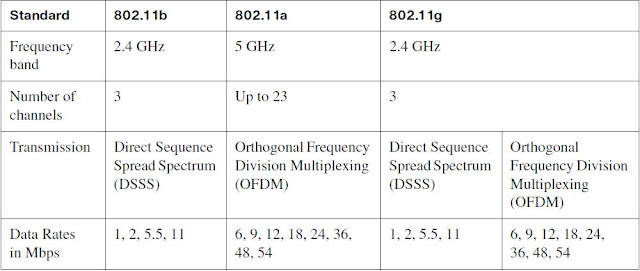IEEE standards define the physical layer and the Media Access Control (MAC) sublayer of the data link layer of the OSI model. The original 802.11 wireless standard was completed in June, 1997. It was revised in 1999 to create IEEE 802.11a/b and then reaffirmed in 2003 as IEEE 802.11g. IEEE 802.11n is an upcoming amendment to the IEEE 802.11-2007 wireless networking standard to improve network throughput over previous standards, such as 802.11b and 802.11g, with a significant increase in the maximum raw, OSI physical layer (PHY) data rate.
802.11a has data rates range from 25 mbps to 54 mbps. Indoor range is 100 feet. Operating frequency is 5 GHz.
802.11b has has data rate range from 6.5 mbps to 11 mbps. Indoor range is 100 feet. Operating frequency is 2.4 GHz.
802.11g has data rate range from 25 mbps to 54 mbps. Indoor range is 100 feet. Operating frequency is 2.4 GHz.
802.11n has data rate range from 200 mbps to 540 mbps. Indoor range is 160 feet. Operating frequency is either 2.4 GHz or 5 GHz.
By design, the standard does not address the upper layers of the OSI model. IEEE 802.11b was defined using Direct Sequence Spread Spectrum (DSSS). DSSS uses just one channel that spreads the data across all frequencies defined by that channel. Table 3-1 shows the different standards and how they compare.
Table 3-1. 802.11 Standards
IEEE 802.11 divided the 2.4-GHz ISM band into 14 channels, but local regulatory agencies such as the FCC designate which channels are allowed, such as channels 1 through 11 in the United States. Each channel in the 2.4 GHz ISM band is 22 MHz wide with 5 MHz separation, resulting in overlap with channels before or after a defined channel. Therefore, a separation of 5 channels is needed to ensure unique nonoverlapping channels. Given the FCC example of 11 channels, the maximum of nonoverlapping frequencies are channels 1, 6, and 11.
Recall that wireless uses half-duplex communication, so the basic throughput is only about half of the data rate. Because of this, the IEEE 802.11b main development goal is to achieve higher data rates within the 2.4-GHz ISM band to continue to increase the Wi-Fi consumer market and encourage consumer acceptance of Wi-Fi.
802.11b defined the usage of DSSS with newer encoding or modulation of Complementary Code Keying (CCK) for higher data rates of 5.5 and 11 Mbps (Barker Coding of 1 and 2 Mbps). 802.11b still uses the same 2.4-GHz ISM band and is backward compatible with prior 802.11 and its associated data rates of 1 and 2 Mbps.
The year that the 802.11b standard was adopted, IEEE developed another standard known as 802.11a. This standard was motivated by the goal of increasing data rates by using a different OFDM spread spectrum and modulation technology and using the less crowded frequency of 5 GHz UNII. The 2.4-GHz ISM band was widely used for all WLAN devices, such as Bluetooth, cordless phones, monitors, video, and home gaming consoles, and it also happens to be the same frequency used by microwave ovens. 802.11a was not as widely known because materials for chip manufacturing were less readily available and initially resulted in higher cost. Most applications satisfied the requirements following the cheaper and more accessible standards of 802.11b.
A more recent development by IEEE maintains usage of the 802.11 MAC and obtains higher data rates in the 2.4-GHz ISM band. The IEEE 802.11g amendment uses the newer OFDM from 802.11a for higher speeds, yet is backward compatible with 802.11b using DSSS, which was already using the same ISM frequency band. DSSS data rates of 1, 2, 5.5, and 11 Mbps are supported, as are OFDM data rates of 6, 9, 12, 18, 24, 48, and 54 Mbps. IEEE requires only mandatory data rates of OFDM using 6, 12, and 24 Mbps, regardless whether it is 802.11a or 802.11g OFDM.

This comment has been removed by a blog administrator.
ReplyDelete